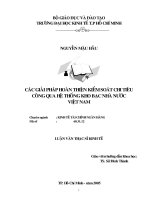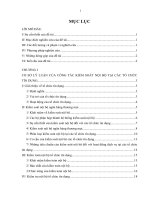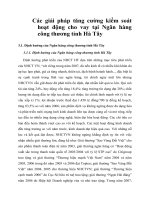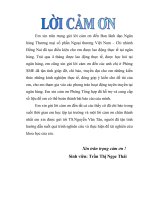Giải pháp mới trong kiểm soát rối loạn thời kỳ mãn kinh bằng Dược dinh dưỡng Phytoestrogen_Tiếng Anh
Bạn đang xem bản rút gọn của tài liệu. Xem và tải ngay bản đầy đủ của tài liệu tại đây (5.17 MB, 41 trang )
<span class='text_page_counter'>(1)</span><div class='page_container' data-page=1>
<b>Clinical management of peri-post menopausal </b>
<b>symptoms with a nutraceutical combination</b>
<b>Dr. Silvia Maffei </b>
<b>Professor M.D, Obstetrics and </b>
<b>Gynecology Clinic of </b>
<b>cardiovascular gynecological </b>
<b>endocrinology </b>
<b>and osteoporosis </b>
<b>CNR (National Research Council) </b>
<b>Foundation </b>
</div>
<span class='text_page_counter'>(2)</span><div class='page_container' data-page=2></div>
<span class='text_page_counter'>(3)</span><div class='page_container' data-page=3></div>
<span class='text_page_counter'>(4)</span><div class='page_container' data-page=4>
In <b>pre-menopausal period </b>women face important hormonal
modifications:
►<b>Decrease of Progesterone levels </b>
►<b>Related Hyperestrogenism </b>
►<b>Increase of FSH (</b>follicle-stimulating hormone)
<b>Important metabolic changes: </b>
► Fat deposition towards androgenic type
►<b>Alteration of lipid metabolism </b>
►Alteration of glucose metabolism
►Alteration of bone metabolism
Anovulation
Irregular periods
Early episodes of hot flashes and serious sweats
<b>Long-term consequences on </b>
<b>Cardiovascular and </b>
<b>Osteo-articular apparatus </b>
</div>
<span class='text_page_counter'>(5)</span><div class='page_container' data-page=5>
<b>Estronet Study 2006 </b>
<b>Symptoms / risks </b> <b>Frequency (in percentage) </b>
<b>Hot flashes </b> <b>86,8% </b>
<b>Night sweats </b> <b>82,1% </b>
<b>Insomnia </b> <b>67,8% </b>
<b>Irritability </b> <b>65,2% </b>
<b>Depression </b> <b>47,5% </b>
<b>Anxiety </b> <b>56,8% </b>
<b>Vaginal dryness </b> <b>>50% </b>
<b>Fatigue </b> <b>49,4% </b>
<b>Paraesthesias </b> <b>34,5% </b>
<b>Vertigo </b> <b>32,8% </b>
<b>Arthritis </b> <b>20,9% </b>
<b>Hypertension </b> <b>20,4% </b>
<b>Osteoporosis </b> <b>13,3% </b>
</div>
<span class='text_page_counter'>(6)</span><div class='page_container' data-page=6></div>
<span class='text_page_counter'>(7)</span><div class='page_container' data-page=7></div>
<span class='text_page_counter'>(8)</span><div class='page_container' data-page=8>
Postmenopausal status and cardiovascular disease risk,
overall
analysis
.
Premenopausal status is the reference.
</div>
<span class='text_page_counter'>(9)</span><div class='page_container' data-page=9>
<b>Postmenopausal status and early menopause as independent </b>
<b>risk factors for cardiovascular disease: a meta-analysis </b>
•
For
early menopause and cardiovascular disease
, the
pooled relative risk estimate was
1.25
(95% CI,
1.15-1.35).
•
In the
stratified analysis
, the pooled effect was 1.38
(95% CI, 1.21-1.58) after controlling
for age and
smoking.
•
The pooled effect of
bilateral oophorectomy
on
cardiovascular disease
was 4.55 (95% CI, 2.56-8.01).
</div>
<span class='text_page_counter'>(10)</span><div class='page_container' data-page=10>
<b> </b>
<b>It is not only a matter of age: </b>
<b>menopause represents the “trigger” for a multi </b>
<b>level metabolic changes …….. </b>
<b>Early clinical management of menopausal </b>
<b>symptoms are requested </b>
</div>
<span class='text_page_counter'>(11)</span><div class='page_container' data-page=11>
Lipids Annual and Estimated Means
</div>
<span class='text_page_counter'>(12)</span><div class='page_container' data-page=12>
<b>Effect of menopause on total cholesterol levels in </b>
<b>women </b>
</div>
<span class='text_page_counter'>(13)</span><div class='page_container' data-page=13>
<b>PROTECTIVE EFFECT OF HIGH HDL </b>
<b>LEVELS ON CARDIOVASCULAR DISEASES </b>
<i><b>modified from Brunner et al, 1987</b></i>
<b>0</b>
<b>50</b>
<b>100</b>
<b>150</b>
<b><200</b> <b>200-224</b> <b>225-249</b> <b>250-264</b> <b>>264</b>
<b>TOTAL CHOLESTEROL</b>
<b>C</b>
<b>O</b>
<b>R</b>
<b>O</b>
<b>N</b>
<b>A</b>
<b>R</b>
<b>Y</b>
<b> EV</b>
<b>EN</b>
<b>TS</b>
<b>/100</b>
<b>0</b>
</div>
<span class='text_page_counter'>(14)</span><div class='page_container' data-page=14></div>
<span class='text_page_counter'>(15)</span><div class='page_container' data-page=15></div>
<span class='text_page_counter'>(16)</span><div class='page_container' data-page=16>
0 0.25 0.5 0.75 1 1.25 1.5 1.75 2
Hazard
ratio
Pravastatin better Placebo better
PROSPER – Cardiovascular end-points according to gender
<b>Pravastatin </b>
<i><b>(n=1396)</b></i>
<i><b>Men</b></i>
<i><b>Placebo </b></i>
<i><b> (n=1408)</b></i>
Cardiac death, non fatal MI, Stroke <sub>222 </sub> <sub>279 </sub>
Cardiac death, non-fatal MI 167 219
Stroke fatal, non fatal 65 70
TIA 38 53
<i><b>Women</b></i> <i><b><sub>(n=1495)</sub></b></i> <i><b><sub>(n=1505)</sub></b></i>
Cardiac death, non fatal MI, Stroke <sub>186 </sub> <sub>194 </sub>
Cardiac death, non-fatal MI 125 137
Stroke fatal, non fatal 70 61
TIA 39 49
</div>
<span class='text_page_counter'>(17)</span><div class='page_container' data-page=17></div>
<span class='text_page_counter'>(18)</span><div class='page_container' data-page=18>
<i><b>PROCAM (Münster Heart Study): </b></i>
<i><b>HDL Cholesterol and Triglycerides </b></i>
<i><b>According to Body Mass Index </b></i>
<i><b>in Women Aged 40-65 Years (n=3.019) </b></i>
<b>61</b>
<b>56</b> <b><sub>55</sub></b>
<b>50</b>
<b>62</b>
<b>40</b>
<b>50</b>
<b>60</b>
<b>70</b>
<b><=20.0</b> <b></b>
<b>20.1-25.0</b>
<b></b>
<b>25.1-27.5</b>
<b></b>
<b>27.6-30.0</b>
<b>>30.0</b>
<b>HDL cholesterol (mg/dl)</b>
<b>Body Mass Index (kg/m2<sub>) </sub></b>
<b>82</b>
<b>95</b>
<b>104</b>
<b>113</b>
<b>79</b>
<b>60</b>
<b>70</b>
<b>80</b>
<b>90</b>
<b>100</b>
<b>110</b>
<b>120</b>
<b><=20.0</b> <b></b>
<b>20.1-25.0</b>
<b></b>
<b>25.1-27.5</b>
<b></b>
<b>27.6-30.0</b>
<b>>30.0</b>
<b>Body Mass Index (kg/m2<sub>) </sub></b>
</div>
<span class='text_page_counter'>(19)</span><div class='page_container' data-page=19>
<i>ESC/EAS guidelines 2011 </i>
<b>Recommended “ lifestyle advice”</b>
</div>
<span class='text_page_counter'>(20)</span><div class='page_container' data-page=20>
It is a natural alkaloid extracted from the bark of <i><b>Berberis </b></i>
<i><b>aristata</b><b>,</b></i> a plant (a spiny shrub) which grows in Tibet and
Himalaya regions.
Berberine traditional use comprehends antimicrobial activity for
infective diarrhea, urinary infections and local treatment for
wound and ulcers.
Kong W et al. Nat Med. 2004; 10:1344-1351
<b>Berberine </b>
</div>
<span class='text_page_counter'>(21)</span><div class='page_container' data-page=21>
<b>Combination of Nutraceuticals </b>
<b>Nutraceutical = nutrition + pharmaceutical </b>
AAPS PharmSci 2003
Nutraceutical can be defined as a “food”
or a part of food that provides medical or
health benefits, including the prevention
and/or treatment of a disease
A pool of nutraceuticals combining, in a single formulation (Armolipid Plus),
natural ingredients in sub-pharmacological dosage for:
• The control of blood lipids:
• Red yeast rice 200 mg
• Berberine 500 mg
• Policosanol 10 mg
• Homocysteine levels
• Folic acid 0,2 mg
• And oxidative stress
• Astaxanthin 0.5 mg
• Coenzyme Q10 2 mg
</div>
<span class='text_page_counter'>(22)</span><div class='page_container' data-page=22>
• The literature was searched on PubMed and SCOPUS database
from inception to February 10, 2016.
• 14 trials met the eligibility criteria for lipid analysis.
• In this publication <b>net changes in measurements </b>(change
scores) of 14 randomized clinical trials (<b>1670 subjects treated </b>
<b>with AP</b>) were calculated and a significant change in the lipid
profile (p<0.001) was obtained.
Pirro M et al. Pharmacological Research 110 (2016) 76-88
<b>in total cholesterol −26.15 mg/dL </b>
<b>in LDL-cholesterol −23.85 mg/dL </b>
<b>in triglycerides −13.83 mg/dL </b>
<b>in HDL-cholesterol +2.53 mg/dL, </b>
p < 0.001
39 mg/dl = 1 mmol/L
<b>-0.7 mmol/L </b>
<b>-0.6 mmol/L </b>
1mmol/L = 89 mg/dl
<b>These effects are related to the Armolipid Plus efficacy. </b>
</div>
<span class='text_page_counter'>(23)</span><div class='page_container' data-page=23>
<b>Reported effects of dietary flavonoids on </b>
<b>RCT, </b>
<b>HDL metabolism, and HDL function </b>
<b>in preclinical and clinical studies </b>
</div>
<span class='text_page_counter'>(24)</span><div class='page_container' data-page=24>
<b>Menopause and CV risks: </b>
<b>Hypertension </b>
<b>Hot flashes </b>
</div>
<span class='text_page_counter'>(25)</span><div class='page_container' data-page=25>
The Influence of Menopause on Blood
Pressure
</div>
<span class='text_page_counter'>(26)</span><div class='page_container' data-page=26>
<i><b>Impact of High-Normal Blood Pressure on the Risk </b></i>
<i><b>of CVD</b></i>
<i><b> Category </b></i> <i><b>Systolic </b></i>
<i><b>(mmHg) </b></i>
<i><b>Diastolic </b></i>
<i><b>(mmHg) </b></i>
<b>Optimal </b> <b><120 </b> <b><80 </b>
<b>Normal </b> <b>120–129 </b> <b>80–84 </b>
<b>High normal </b> <b>130–139 </b> <b>85–89 </b>
<b>Grade 1 hypertension </b>
<b>(mild) </b> <b>140–159 </b> <b>90–99 </b>
<b>Grade 2 hypertension </b>
<b>(moderate) </b> <b>160–179 </b> <b>100–109 </b>
<b>Grade 3 hypertension </b>
<b>(severe) </b> <b>>180 </b> <b>>110 </b>
<b>Isolated systolic </b>
<b>hypertension </b> <b>>140 </b> <b>90 </b>
Journal of Hypertension 2003, Vol 21 No 6
Definitions and Classification of Blood Pressure Levels
</div>
<span class='text_page_counter'>(27)</span><div class='page_container' data-page=27>
<i><b>Hot flash correlates with high blood </b></i>
<i><b>pressure </b></i>
</div>
<span class='text_page_counter'>(28)</span><div class='page_container' data-page=28>
<b>Potential protective effects of genistein in hypertension </b>
<b>through promoting vasodilation and reducing vascular </b>
</div>
<span class='text_page_counter'>(29)</span><div class='page_container' data-page=29></div>
<span class='text_page_counter'>(30)</span><div class='page_container' data-page=30></div>
<span class='text_page_counter'>(31)</span><div class='page_container' data-page=31>
<b>50</b>
<b>60</b>
<b>70</b>
<b>80</b>
<b>90</b>
<b>100</b>
<b>0</b> <b>20</b> <b>40</b> <b>60</b> <b>80</b> <b>100</b> <b>120</b>
<b>P</b>
<b>roportion </b>
<b>W</b>
<b>it</b>
<b>hout</b>
<b>C</b>
<b>ardiov</b>
<b>as</b>
<b>cular</b>
<b> E</b>
<b>v</b>
<b>ent</b>
<b> (</b>
<b>%</b>
<b>) </b>
<b>Months </b>
<i><b>Flow-Dependent Dilation </b></i>
<b>19.0% dilation </b>
<b>10.3% to <19.0% dilation </b>
<b>10.3% dilation </b>
<b>Schachinger V, et al. </b><i><b>Circulation.</b></i><b> 2000;101:1899-906. </b>
<i><b>P</b></i><b> = .004 </b>
<b>(log rank, pooled) </b>
</div>
<span class='text_page_counter'>(32)</span><div class='page_container' data-page=32>
<b>HRT refusal/withdrawal reasons</b>
</div>
<span class='text_page_counter'>(33)</span><div class='page_container' data-page=33></div>
<span class='text_page_counter'>(34)</span><div class='page_container' data-page=34>
<b>Estrogenic effectiveness </b>
<b>Estradiol </b> <b>100 </b>
<b>Genistein </b> <b>0,084 </b>
<b>Equolo </b> <b>0,061 </b>
<b>Daidzein </b> <b>0,013 </b>
<b>Receptor Affinity </b>
<b>ERα </b> <b>ERβ </b>
<b>Estradiol </b> <b>100 </b> <b>100 </b>
<b>Genistein </b> <b>4 </b> <b>87 </b>
<b>Daidzein </b> <b>0,1 </b> <b>0,5 </b>
<b>Breast </b>
<b>Kidney, </b>
<b>gut, lung </b>
<b>Endometrium</b>
<b>Ovary, </b>
<b>Stroma </b>
<b>Brain </b>
<b>Endothelium </b>
<b>vascular </b>
<b>Bones </b>
<b>Soy Isoflavones : estrogenic selective activity </b>
</div>
<span class='text_page_counter'>(35)</span><div class='page_container' data-page=35>
<b>Dosage of Isoflavones </b>
The dosage of I.s. essential to obtain
a biologic effect is
<b>50-90 mg / day. </b>
The dosage of I.s. considered safe is lower
then
<b>2mg/kg</b>
of body weight
2.
<i>1<sub>Messina, Womens Health, 2008 - </sub>2<sub>Barnes, Br J Nutr 2003 </sub></i>
<i><b>I.s. are in GRAS list </b></i>
</div>
<span class='text_page_counter'>(36)</span><div class='page_container' data-page=36>
<b>Conversion of isoflavones in active forms by </b><i><b>Lactobacillus sporogenes</b></i><b>.</b>
</div>
<span class='text_page_counter'>(37)</span><div class='page_container' data-page=37>
-100
-80
-60
-40
-20
0
2 4 8 12 24
Tempo (Setti ma ne)
D
if
fer
en
za
d
el
p
un
teg
gi
o
vs
il
ba
sa
le
(%
)
-100
-80
-60
-40
-20
0
2 4 8 12 24
Tempo (Setti ma ne)
D
if
fer
en
za
d
el
p
un
teg
gi
o
vs
il
ba
sa
le
(%
)
-100
-80
-60
-40
-20
0
2 4 8 12 24
Tempo (Setti ma ne)
D
if
fer
en
za
d
el
p
un
teg
gi
o
vs
il
ba
sa
le
(%
)
Hot flushese Night sweats
Palpitation
* p < 0,05 tra trattamenti
***
***
***
***
***
***
*** <sub>*** </sub> <sub>*** </sub>
***
*** <sub>*** </sub>
*
* p < 0,001 tra trattamenti
IS
Vit D<sub>3</sub> + calcio
Mucci et al. Soy Isoflavones, Lactobacilli, Magnolia Bark extract, Vitamin D3 and Calcium. Controlled clinical study in menopause. Minerva Ginecol. 2006 Aug; 58(4):323-34
</div>
<span class='text_page_counter'>(38)</span><div class='page_container' data-page=38>
<i>181 gynaecologists collected a sample of 1398 </i>
<i>menopause women of which 607 not treated, </i>
<i>327 on estrogens, and 464 on phytoestrogens. </i>
<i>392 women used a phytoestrogen named <b>Estromineral</b></i>
<i><b>containing isoflavones </b>(genistine 30mg and daidzine </i>
<i>30mg) +Lactobacillus sporogenes +Ca +vit.D3. </i>
<i>The mean treatment duration was 112.9 days. </i>
<i> Giorn. It. Ost. Gin. Vol. XXVIII - n. 5 (2006)</i>
<b>Concomitant therapies according to the stratification in </b>
<b>menopause treatments </b>
</div>
<span class='text_page_counter'>(39)</span><div class='page_container' data-page=39>
<b>Clinical activity of EM related to duration of treatment</b>
<b>100 </b>
<b>83 </b>
<b>90 </b>
<b>96 </b>
<b>95 </b>
<b>86 </b>
</div>
<span class='text_page_counter'>(40)</span><div class='page_container' data-page=40>
<b>Conclusion </b>
• Women treated (HRT or phytoestrogens) appear more controlled
both before and during the treatment.
• In presence of concomitant clinical conditions, the natural
approach with phytoestrogens are preferred.
• Phytoestrogens plus lactobacilli and mineral supplement show a
</div>
<span class='text_page_counter'>(41)</span><div class='page_container' data-page=41></div>
<!--links-->









